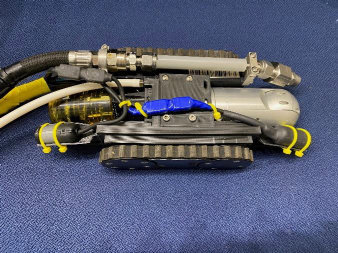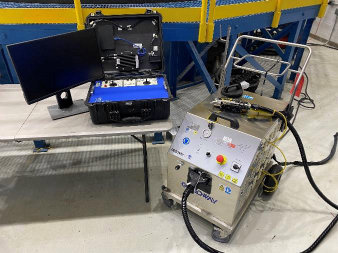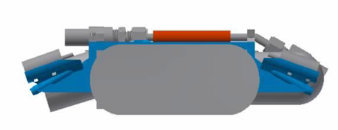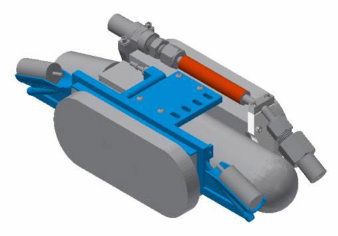Background
PWR operators are required to perform bare metal visual (BMV) inspections of their Reactor Vessel Heads (RVH) including the interface around each CRDM / CEDM penetration, head vent (if present), and 100 percent of the bare metal down to the flange in accordance with code case N-729-6.
To meet this inspection requirement, Westinghouse Inspection Services (WIS) has developed a remotely operated system to visually inspect these areas with the additional capability to clean boric acid deposits and debris located during the visual inspection.
Description
The inspection robot is a small, remotely operated vehicle that can be deployed within the gap between the RVH surface and the bottom of the insulation package on most RVH’s (see Figure 1).

Figure 1 – RVH BMV Inspection System crawler with air puffer and steam cleaning attachment.
The inspection robot carries a series of color cameras that can perform the required qualified visual inspections.
The control station for the inspection robot can be located in a low radiological dose area upwards of 100 feet away from the RVH (see Figure 2).

Figure 2 – RVH BMV Inspection System with remote control unit and steam cleaning unit.
If boric acid deposits or debris on the RVH are noted during the visual inspection, it is critical that they are well documented for future reference. The source of the deposits or debris must be determined and then cleaned thoroughly to ensure an adequate as-left condition in order to establish a base line for future inspections.
The Westinghouse crawler is fully equipped with on-board cleaning capabilities to address boric acid deposits or debris that may be identified during the visual inspection. Cleaning processes include the use of both an air interrogation “puffer” system to blow away very light, loose debris and a super-heated steam cleaning wand to address heavier, more tightly adhered boric acid deposits.
The steam cleaning wand on the inspection robot permits cleaning of the surface of the RVH and up the CRDM / CEDM penetration tube up to four inches from the RVH surface depending on overhead clearance (see Figure 3).


Figure 3 – RVH BMV Inspection System – Steam cleaning wand.
In addition to performing BMV inspections of the RVH, the configuration of the inspection robot allows for it to be utilized for the BMV inspection of the outside surface of the bottom RVH and Bottom Mounted Instrumentation (BMI) tubes.
Benefits
The remotely operated inspection robot permits greater accuracy of inspection with lower radiological dose when compared to direct visual inspection.
The low profile of the inspection robot typically allows for inspections to be performed with the RVH insulation in place providing additional schedule and dose savings.
Westinghouse’s custom-made inspection software combines high-definition video and photographs to create an easy to navigate database detailing the entirety of the inspection. This allows for up-to-the-minute status of the inspection to be easily provided.
The interactive digital inspection report allows customers to save all the data in one location and reduces review time. Specifically identified CRDM / CEDM and BMI penetrations can be pulled up and still photos of any one of the four quadrants of that location can be selected and enlarged for detailed examination.
The additional cleaning capability of the inspection robot provides a more in-depth visual inspection and gives customers a method to remove small boric acid deposits in hard-to-reach areas on the RVH and bottom of the RV.
Deliverables
The Westinghouse Inspection Services team can provide a complete turnkey BMV inspection of the RVH and bottom of RV well within the customer’s defuel window. The full integration of our new steam cleaning wand to our proven inspection robot provides a time savings to our customers by being able to remove boric acid deposits during the inspection process verses reentering the region with alternate tooling to complete the task.
Experience
Westinghouse has been an industry leader of remote BMV inspections using our industry-proven crawler coupled with the air interrogation “puffer” cleaning system. Our continual pursuit of innovative technology to meet industry demands now brings the steam cleaning wand to our delivery system. This further enhances our services by adding the capability of removing boric acid deposits or other debris as soon as they are discovered during the inspection process.





